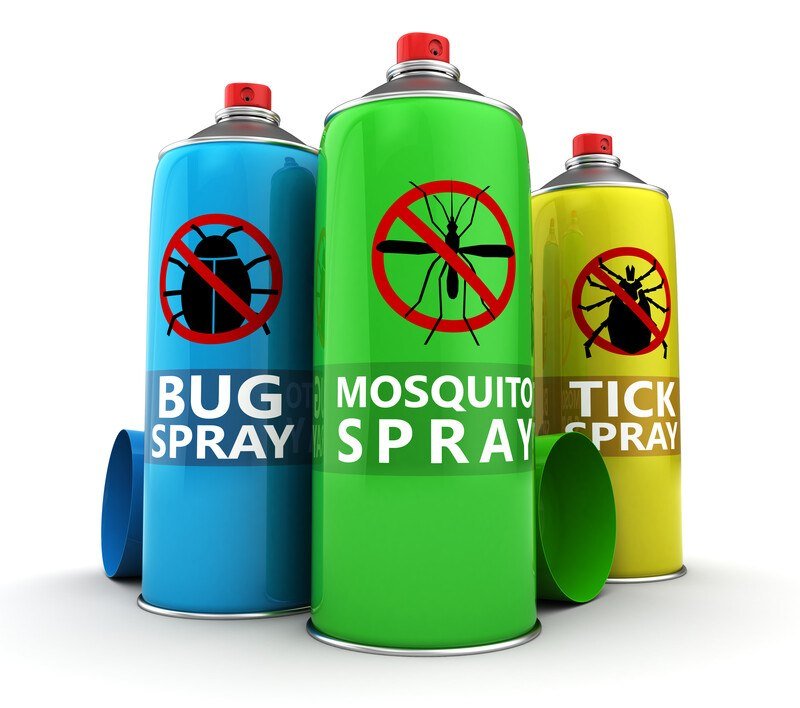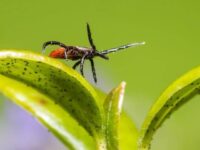This post contains affiliate links. If you click on a link and make a purchase I earn a commission at no extra cost for you.
Ticks can transmit serious diseases. Protecting yourself from tick bites is essential. One of the most effective ways to avoid ticks is by using a reliable tick repellent. But how can you know which is the best tick repellent for humans?
Scientific research and field testing of tick repellent for humans have helped identify several synthetic ingredients that are effective at repelling ticks. These ingredients are recommended by the Centers for Disease Control (CDC) and the Environmental Protection Agency (EPA).
In this article, we’ll explore the four most effective synthetic tick repellents and one natural tick repellent.
The 4 Synthetic Tick Repellents
Here are the four synthetic active ingredients that are scientifically proven to work against ticks.
1. DEET (N,N-Diethyl-meta-toluamide)
DEET is widely considered one of the most reliable and effective insect repellents. Its strong insect-repelling effect works against all sorts of biting insects.
Effectiveness: Highly effective
Duration: 2–10 hours, depending on concentration
Approved by: EPA, CDC
DEET is perhaps the most well-known insect and tick repellent for humans in the world. Originally developed by the U.S. Army in 1946, DEET has been in use for over 70 years and is backed by extensive scientific research.
How it works: DEET confuses and deters ticks and other biting insects by disrupting their ability to detect body heat and chemicals like carbon dioxide and lactic acid, which they use to find hosts.
Advantages:
- Proven long-lasting protection
- Available in a wide range of concentrations
- Works against ticks, mosquitoes, fleas, and other pests
Disadvantages:
- Can damage synthetic fabrics and plastics
- Has a greasy feel and strong odor for some users
Best uses: DEET repellents with 25% and 40% concentrations both offer strong protection against mosquitoes, ticks, and other biting insects, but differ in duration. A 25% DEET product typically provides about 6–8 hours of protection, making it suitable for day hikes, outdoor sports, or evening use. A 40% DEET repellent offers longer-lasting defense, up to 10 hours, ideal for extended exposure in heavily infested areas. However, higher concentrations don’t increase effectiveness, only duration. For most users, 25% is sufficient and preferred due to reduced skin absorption.
- DEET mosquito repellent formulated with 25% DEET
- Long-lasting protection from mosquitoes, ticks, biting flies, gnats, and chiggers
- Ideal for camping, fishing, hiking and hunting with up to 8 hours of mosquito protection
- Anti-tick spray that protects against ticks that may carry Lyme disease
- Do not apply to gear or clothes made of rayon, spandex, or synthetic materials other than nylon
- REPELS: Create a barrier against mosquitoes, including those that may transmit the Zika, West Nile, Dengue and Chikungunya viruses, ticks, gnats, biting flies, chiggers and fleas.
- CONTAINS 40% DEET: Provides long-lasting protection in the great outdoors.
- DEVELOPED FOR OUTDOOR ENTHUSIASTS: Especially for campers, backpackers, golfers, hunters, bikers, hikers, joggers, ball players and others who are active outdoors.
- LASTING PROTECTION: Long-lasting protection ensures that you have the toughest repellent for any adventure.
- PUMP SPRAY: Liquid spray pump is easily packed with your outdoor gear so it's ready whenever you need it.
Last update on 2025-07-07 / Affiliate links / Images from Amazon Product Advertising API
2. Picaridin (also known as Icaridin or KBR 3023)
Picaridin is a widely used insect repellent effective against mosquitoes and ticks. It’s odorless, non-greasy, and less irritating than DEET, offering up to 12 hours of protection.
Effectiveness: Comparable to or better than DEET
Duration: 4–12 hours, depending on concentration
Approved by: EPA, CDC, WHO
Picaridin is a synthetic compound developed in the 1980s. It offers similar protection to DEET but with a lighter feel and less odor, making it a popular alternative.
How it works: Picaridin works by blocking the olfactory receptors of ticks and insects, making it harder for them to locate humans.
Advantages:
- Odorless or lightly scented
- Doesn’t damage plastics or clothing
- Non-greasy and pleasant to use
Disadvantages:
- Not as widely available in some countries
- May be less effective at very low concentrations
Best uses: Great for individuals sensitive to DEET or needing protection without chemical smell or clothing damage.Picaridin comes in concentrations typically ranging from 10% to 20%. A 10% picaridin formula offers about 4–6 hours of protection, suitable for everyday outdoor activities like walking, gardening, or picnics. The 20% concentration provides up to 12 hours of defense, making it ideal for camping, hiking, or travel in insect-heavy regions.
- Non-greasy, fragrance free, odorless; Dries quickly and won't damage plastics or synthetic coatings — safe for use on clothing, backpacks, watches, sunglasses, fishing line, firearm finishes, and more
- Safe for use on the whole family, long-lasting insect and tick repellent lotion deters a wide variety of pests — up to 14 hours against mosquitoes and ticks and up to 8 hours against flies, gnats, and chiggers
- Fragrance-free topical insect repellent with 20% Picaridin — more effective at repelling biting flies than DEET; repels disease-spreading ticks (Lyme, tick-borne encephalitis) and mosquitoes (West Nile, Dengue, and Zika viruses), chiggers, and more
- Very comfortable to wear on your skin, it's ideal for all your outdoor adventures, from camping, backpacking, hunting, and fishing to backyard BBQs, sporting events, days at the park, and more
- Top rated bug repellent by WireCutter/New York Times (May, 2020); maximize protection by pairing with Sawyer Permethrin tick and insect repellent spray for clothing and gear
Last update on 2025-07-07 / Affiliate links / Images from Amazon Product Advertising API
3. IR3535 (Ethyl butylacetylaminopropionate)
IR3535 is a synthetic insect repellent considered safe and effective against a wide range of insects, including mosquitoes, ticks, lice, and flies.
Effectiveness: Moderate to high (depending on species and concentration)
Duration: Up to 8 hours
Approved by: EPA, European Union, CDC
IR3535 has been used in Europe for over 20 years and is gaining popularity in North America. It is a derivative of beta-alanine, an amino acid, and is considered to be safe and non-toxic. Compared to DEET, IR3535 is less greasy and has a milder odor, making it more pleasant for daily use. It is biodegradable and poses low toxicity to humans and the environment.
How it works: It works by confusing insects’ olfactory systems, making it harder for them to detect human presence.
Advantages:
- Generally recognized as safe for children and pregnant women
- Less toxic to aquatic life compared to DEET
- Less irritating to skin
Disadvantages:
- May require more frequent reapplication
- Can degrade some plastics
Best uses: Suitable for sensitive individuals, including children and those concerned about environmental impact. IR3535 is commonly found in lotions, sprays, and wipes and is approved for use on both adults and children over six months old.
Last update on 2025-07-07 / Affiliate links / Images from Amazon Product Advertising API
4. Permethrin
Permethrin is a synthetic chemical that belongs to the pyrethroid family, modeled after natural compounds from chrysanthemum flowers. Permethrin is widely used in agriculture, public health, and personal protection products, such as treated clothing, mosquito nets, and sprays.
Effectiveness: Extremely effective on clothing and gear (not for skin use)
Duration: Up to 6 weeks or 6 washings when applied to fabric
Approved by: EPA, CDC, U.S. military
Permethrin is different from the other repellents listed — it’s an insecticide rather than a traditional repellent and should not be applied to the skin. It is used to treat clothing, shoes, tents, and gear. When a tick comes into contact with permethrin-treated fabric, it quickly becomes incapacitated and dies.
How it works: Permethrin affects the nervous system of ticks, paralyzing and killing them on contact.
Advantages:
- Kills ticks on contact
- Long-lasting protection when used on clothing
- Odorless once dry
Disadvantages:
- Cannot be applied to skin
- Requires pre-treatment or use of pre-treated clothing
Best uses: Hiking, camping, hunting, or any extended outdoor activity where tick exposure is high. Permethrin is highly effective when used on clothing and gear.
- Permethrin spray bonds to fabric fibers for up to 6 weeks or through 6 washings (whichever comes first) won't stain or damage clothing, fabrics, plastics, finished surfaces, or outdoor gear; fragrance free
- Reduce likelihood of a tick bite by 73.6 times by treating shoes and socks with Permethrin (University of Rhode Island study - 2017); maximize protection by pairing with Sawyer Picaridin topical repellent for the skin
- Add a layer of protection to your clothing and gear with Permethrin insect and tick repellent spray — perfect for use on shirts, jackets, pants, socks, shoes, boots, sleeping bags, tents, netting, when outdoors, camping, hunting, or on travel
- Ideal for backpacking, backyard BBQs, hunting, and other outdoor activities, it's effective against more than 55 kinds of insects — from disease-spreading ticks (Lyme) and mosquitoes (West Nile & Zika) to chiggers, spiders, mites, and more
- Sawyer Permethrin stays effective despite sweat or water, degrades via UV exposure or washing machine agitation; each 24-ounce trigger spray bottle treats 5 outfits (EPA now reconmends 4.5 ounces per outfit consisting of shirt, pants, and socks)
Last update on 2025-07-07 / Affiliate links / Images from Amazon Product Advertising API
Best Natural Tick Repellent
Oil of Lemon Eucalyptus (OLE) is often considered a fifth effective tick repellent for humans, particularly for those seeking a plant-based alternative to synthetic chemicals. The CDC recognizes OLE as a valid alternative to DEET and picaridin, especially in formulations containing at least 30% PMD.
5. Oil of Lemon Eucalyptus (OLE) / PMD (p-Menthane-3,8-diol)
Oil of Lemon Eucalyptus (OLE) is a natural insect repellent made from the leaves of the lemon eucalyptus tree.
Effectiveness: Moderate to high
Duration: Up to 6 hours
Approved by: CDC, EPA (when formulated as PMD)
Oil of Lemon Eucalyptus (OLE) is a naturally derived repellent made from the leaves of the lemon eucalyptus tree (Corymbia citriodora). Its active compound, p-menthane-3,8-diol (PMD), is the only plant-based ingredient recommended by the CDC for repelling ticks and mosquitoes. Though technically not synthetic, PMD is often refined for commercial use, and its performance is comparable to lower concentrations of DEET in controlled studies.
How it works: PMD masks the human scent that attracts ticks and mosquitoes, interfering with their ability to locate a host. While it may not last as long as DEET or picaridin, OLE offers several hours of protection and is generally well tolerated by most users.
Advantages:
- Plant-derived and considered more natural than synthetics
- Effective for short to moderate outdoor activities
- Pleasant citrus-like scent
Disadvantages:
- Shorter duration of protection than DEET or picaridin
- Not recommended for children under 3 years old
- Less widely available in some regions
Best uses: Ideal for those seeking a natural alternative for moderate exposure to ticks and insects, especially during short hikes or yard work.
- MADE WITH OIL OF LEMON EUCALYPTUS: This DEET-free insect repellent provides you with protection during adventures in the backyard and on the go.
- REPELS MOSQUITOES FOR UP TO 6 HOURS: This repellent keeps you and your family protected for hours, so the fun doesn't have to end.
- REFRESHING SCENT: This DEET-free personal repellent leaves you with a cool, refreshing scent so you don't have to put up with the usual bug spray smell.
- REPELS: Create a barrier against mosquitoes, including those that may transmit the Zika, West Nile, Dengue and Chikungunya viruses.
- NOT GREASY OR STICKY: Formulated with oil of lemon eucalyptus to provide protection without leaving your skin feeling sticky or greasy.
Last update on 2025-07-07 / Affiliate links / Images from Amazon Product Advertising API
How to Choose the Right Repellent
The best tick repellent for you depends on your environment, length of exposure, sensitivity, and preferences. Here are some general guidelines:
- For day hikes or walks in moderate-risk areas: Picaridin or DEET sprays around 20–30% concentration should be sufficient.
- For extended outdoor activities, deep woods or tropics: Higher concentrations of DEET or permethrin-treated clothing offer stronger protection.
- For children and sensitive skin: IR3535 and picaridin are gentler alternatives to DEET.
- For clothing treatment: Permethrin is unmatched in killing ticks before they bite.
Natural vs. Synthetic RepellentsWhile many people prefer “natural” solutions, most natural tick repellents (like citronella, lavender, or tea tree oil) are significantly less effective than synthetic alternatives. Oil of lemon eucalyptus (OLE) is an exception and is sometimes recommended by the CDC, but it still doesn’t last as long or work as reliably as DEET, picaridin, or permethrin.
|
Why Tick Repellents Are Important
Tick-borne diseases are on the rise in many parts of the world, particularly in North America, Europe, and parts of Asia. Some tick-borne illnesses can have long-term health consequences or even be life-threatening. Since ticks often latch onto humans and pets without being felt, prevention is key. Wearing long clothing, staying on trails, and performing tick checks help, but using a proven tick repellent for humans is one of the best defenses.
Tick repellents are a critical tool in protecting yourself and your family from tick bites and the serious illnesses they can cause. The four synthetic tick repellents with proven effectiveness are:
- DEET – reliable, long-lasting protection
- Picaridin – nearly as effective as DEET with fewer downsides
- IR3535 – gentle on skin, good for children and sensitive users
- Permethrin – highly effective for treating clothing and gear
- Oil of Lemon Eucalyptus – only plant-based repellent recommended by the CDC
| No repellent is 100% effective, so it’s best to combine repellents with other preventive measures like wearing long sleeves, performing tick checks, and avoiding high-risk areas. With the right combination of strategies, you can safely enjoy the outdoors without fear of tick-borne illness. |
Best Tick Repellent For Humans Comparison Chart
| Repellent | Active Ingredient | Effectiveness | Duration of Protection | Best For | Safety Notes |
|---|---|---|---|---|---|
| DEET | N,N-Diethyl-meta-toluamide | High | 2–10 hours | Long hikes, high-risk areas | Can irritate skin; avoid contact with plastics and synthetic fabrics |
| Picaridin | Icaridin | High | 8–14 hours | Sensitive skin, family use | Odorless, non-greasy; safe on plastics |
| IR3535 | Ethyl butylacetylaminopropionate | Moderate to High | Up to 8 hours | Children, sensitive individuals | May irritate eyes; avoid contact with plastics |
| Permethrin | Permethrin | Very High (for treated clothing) | Up to 6 weeks or 6 washings | Treating clothing and gear | Not for skin use; can damage fabrics if not applied correctly |
| Oil of Lemon Eucalyptus (PMD) | Para-menthane-3,8-diol (PMD) | Moderate | Up to 6 hours | Natural alternative users | Not for children under 3; can cause skin irritation |
Sources and more Info:
CDC about the prevention of tick bites:
https://www.cdc.gov/ticks/prevention/index.html
EPA Tips to Prevent Tick Bites
https://www.epa.gov/insect-repellents/regulation-skin-applied-repellents










